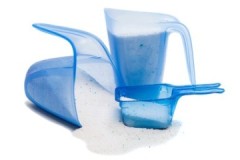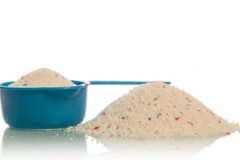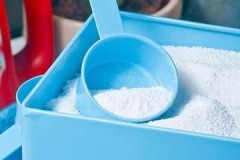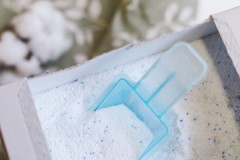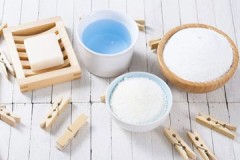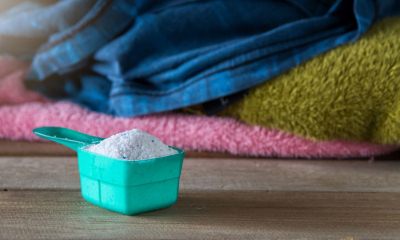 Today, washing powder is taken for granted. Without it, a full-fledged process of washing things is impossible. However, just 150 years ago, people did not even know what it was.
Today, washing powder is taken for granted. Without it, a full-fledged process of washing things is impossible. However, just 150 years ago, people did not even know what it was.
The article will talk about the history of the creation of washing powder, its benefits and harms to human health and the environment, the leading manufacturers of detergents and more will be listed.
Content
Description of the detergent for clothes
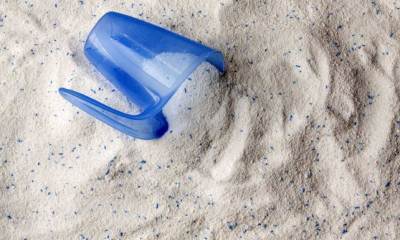 Washing powder - this is a synthetic detergent related to household chemicals.
Washing powder - this is a synthetic detergent related to household chemicals.
Powders have a complex, multicomponent composition, depending on which the specificity of their application differs.
All modern powder products undergo granulation, which reduces the degree of dusting, and also makes the process of use more convenient.
They are white in color, but in their composition you can often find multi-colored granules (green, red, light blue, blue). The main purpose of powders is to wash off dirt.
History of creation
The first washing powder was created by the German chemist Fritz Henkel. At that time, it was based on sodium silicate. In 1876, Fritz formed the Henkel Company, which launched a new product called bleaching soda. It quickly became popular as it washes things well and was inexpensive.
The first soap powder appeared on the market a year later. Its creators founded Thompsons Seifenpulver GmbH. The Henkel factory developed in parallel.
In Russia, washing powder appeared only in 1953, it was a product called "News". It was produced in Kazan at a chemical plant. A new round in development took place in 2000, as a result, a powder with a composition familiar to modern people entered the market.
What is the harm?
The only benefit of powders is their ability to well remove various impurities from things, making them clean. However, they are harmful to the human body and the environment.
For the human body
Surfactants, which make up the basis of washing powders, are highly active compounds. When they enter the body, they accumulate in the cell membranes, covering them with a film and disrupting their functioning. If a lot of surfactants accumulates in the body, they disrupt metabolic processes and can even lead to cell destruction.
 Anionic surfactants are especially dangerous.... Their harmful effects on the body:
Anionic surfactants are especially dangerous.... Their harmful effects on the body:
- violation of immunity;
- provocation of allergies;
- brain damage;
- increased blood cholesterol levels, increased symptoms of atherosclerosis;
- malfunctions of the nervous system;
- violations in the functioning of the liver, kidneys, respiratory system.
ASA have the property of accumulating in internal organs. When they come into contact with unprotected skin, 0.6% of them are deposited in the liver, and 1.9% in the brain. They have a toxic effect on them.
Phosphates from washing powder only enhance the effect of anionic surfactants, promote their penetration through the skin and enhanced destruction of membranes. High toxic concentrations of surfactants remain on things for about 4 days.
Impact on the environment
Waste water contains synthetic detergents. After working off, they end up in the sewage system, and then into natural reservoirs. For the microorganisms living in them, the substances contained in the powders are poisons. They violate the organoleptic properties and biological characteristics of water.
Due to surfactants and other harmful chemicals entering the water, reservoirs begin to bloom, turning into swamps.
Variety of shapes and types
There are the following types washing powders:
 Universal formulations for different types of washing.
Universal formulations for different types of washing.- Washing machines in a typewriter.
- For hand wash.
- For delicate wash.
- With disinfectants in the composition.
- For white and colored laundry.
- For children's clothing.
- With air conditioning.
- For washing in hard or cold water, etc.
Different manufacturers produce different powders. They differ not only in composition, but also in smell. There are three types of detergents:
- conventional free-flowing powders;
- gels represented by liquid concentrates;
- capsules - they contain a highly concentrated liquid gel.
It is most convenient to use capsules, since they do not need to be dosed, they do not generate dust or irritate the respiratory tract. However, they cost 2-3 times more than a classic washing powder.
Features of choosing a washing composition
When choosing a washing powder, you need to consider its purpose. A prerequisite is the study of the composition. You should not buy household chemicals that have expired.
Other points to pay attention to:
- Number of APAS. According to existing standards, their percentage should be less than 5%.
- All means of foreign production must have Russian-language information.
- The composition should not contain phosphates, responsible manufacturers replace them with safer zeolites.
- Purpose of the detergent. If the label has a mark "for white things", then it is not recommended to wash colored items.
- The composition of baby powder should be as natural as possible.
- The packaging must be tightly sealed, without any signs of opening.
How to choose a washing powder, read here, for children's things - here... The rating of hypoallergenic laundry detergents is presented in this article, odorless powders - in this, eco-powders - in this.
The difference between powder for hand washing and "automatic" is considered here, features of the choice of soap powder - heresafe for a septic tank - in this article, rating of detergents according to customer reviews is presented here.
Top producing countries
Powders are produced in many countries, but the following countries are leaders in this industry:
 Japan. As part of Japanese detergents there are no phosphates, as they have been banned in the country for several years. They are available in convenient modern packaging, equipped with a measuring spoon. Most popular brands: Attack, Lion, Miyoshi, Daiichi FUNS, Mitsuei Super Wash.
Japan. As part of Japanese detergents there are no phosphates, as they have been banned in the country for several years. They are available in convenient modern packaging, equipped with a measuring spoon. Most popular brands: Attack, Lion, Miyoshi, Daiichi FUNS, Mitsuei Super Wash.- China. Chemistry made in China, differs in economical consumption, minimal amount of flavorings, high efficiency and hypoallergenic composition. Popular brands: Liby, Keon, BioAqua, Laundry Detergent Sheets, Touching Nature.
- Korea. In the formula Korean washing powders there are no phosphates, and the main active component is enzymes (enzymes) that are safe for human health and the environment. The most popular TMs: KeraSys Spark Drum, OATS, Lion Beat, Hanjang.
- Russia. Most formulations are phosphate-free and affordable. Most popular brands: Eared nanny, Umka, Sarma, Villain, Stork, Sorti, Lotus.
- Belarus. Washing powders from Belarus they wash well, do not contain phosphates and undergo strict control when entering the Russian market. Popular brands: Mara, April, Chaika, SanDay.
You can learn about German washing powders from this articles.
Composition
All washing powders are based on anionic and nonionic surfactants. These surfactants weaken the bonds between dirt and fabric fibers, preventing them from re-settling.
In addition to surfactants, the composition of detergents is represented by the following components:
- Optical brighteners that create the illusion of snow-white linen. This effect is achieved due to the deposition of luminescent particles on the fabric. When sunlight hits them, things appear white.
- Oxygen bleach.
- Soda and soap. They are designed to improve the quality of washing.
- Fragrances and fragrances that are responsible for eliminating unpleasant odors and giving freshness to the washed laundry.
- Phosphates. These components are necessary to soften the water, which improves the quality of the wash. Phosphates soften the laundry and protect the elements of the washing machine from limescale.
- Zeolites. They act as a safer alternative to phosphates.
- Sodium silicate, which alkalizes the surfactant and also binds powder dust into granules.
- Enzymes (enzymes). They break down various types of contaminants through the manifestation of their biological activity.
- Defoamers. These substances prevent excess foam formation.
Other components:
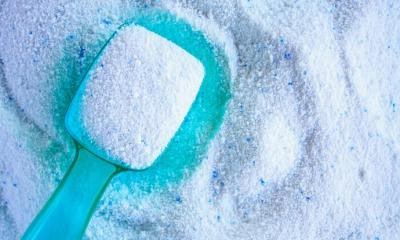 ballast substances,
ballast substances,- solvents,
- chlorine,
- hydrotropes,
- anti-corrosion compounds,
- preservatives,
- antioxidants,
- hand softening additives
- air conditioner, etc.
Read more about the composition of the washing powder. here, about the requirements of GOST - here.
Features of use
Recommendations for use washing powders:
- compliance with dosage and temperature conditions;
- the use of powders, according to their purpose (for white and colored linen, for children, for people with increased skin sensitivity);
- when washing in an automatic machine, powder is poured into the first compartment only under the condition that a pre-wash or soaking program has been selected, in other cases, the detergent is poured into the second section;
- accounting for the concentration of chemicals - if the powder is concentrated, the dosage is reduced.
The rating of washing powders for colored items is presented in this article, for black - in this, for white - here, for hand wash - here.
Is it possible to pour the powder directly into the drum, will tell this article, where is it right, in which compartment - thishow much to pour - this.
Storage conditions
The composition can be stored both in its original packaging and in other suitable containers. The main thing is that the container is tightly closed.... Do not allow moisture and debris to enter.
The room is chosen dry, dark and cool. Children should not have access to detergent. It is important to monitor the expiration date of the composition and not to use expired products. Read about the expiration dates for washing powders here.
Helpful information
Tips for selection and use washing powder:
 If you want to protect yourself as much as possible from the effects of harmful substances, you should give preference to soap-based powders.
If you want to protect yourself as much as possible from the effects of harmful substances, you should give preference to soap-based powders.- Choose powders with a low pH level, which is close to the skin's pH of 4.5.
However, one should be prepared for the fact that such a level of acidity negatively affects the detergent properties of the composition, therefore it will be worse to wash it.
- When washing by hand, you need to protect your skin from contact with the detergent solution.
- Dust from washing powder can remain in the air for about 20 minutes. Therefore, it is strongly discouraged to put a washing machine in the kitchen.
How to replace the washing powder, if it runs out, you can find out herehow to do it yourself - here.
Conclusion
It is impossible to imagine the life of a modern person without washing powder. To minimize its harm to health and the environment, it is necessary to give preference to the most natural formulations, without prohibited components.
It is necessary to use the powder according to the instructions., which improves the quality of washing.
